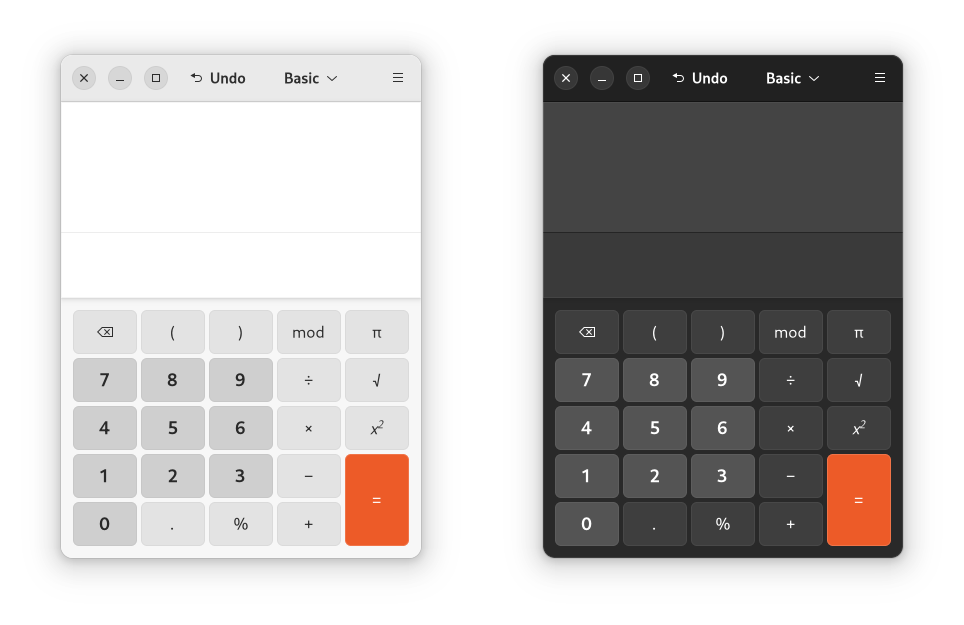A Yaru and Libadwaita inspired theme designed to provide a consistent experience across GTK desktops.
Read more about the theme here.
Supports GNOME 42+, Budgie 10.6+, Cinnamon, Unity7, Xfce, and Mate.
There is also a variant of the theme with Libadwaita style window controls.

More screenshots can be seen here.
This repo contains a GTK3 theme, a configuration for Libadwaita, a Firefox theme, a VS Code theme, and themes for the desktops listed above.
The Yaru icon, cursor, sound, and GtkSourceView themes are also included.
A modern version of Python is required. Any currently supported version should work.
If you are going to install the VS Code theme, you will need to install pyjson5 along with the other dependencies listed below. To install it, run this:
pip install json5
Includes Arch, Manjaro, Garuda, EndeavourOS, etc.
sudo pacman -S sassc git ninja meson rsync
If you are going to install the GNOME Shell theme, also run this and then log out and log back in:
sudo pacman -S gnome-shell-extensions
Includes Debian, Ubuntu (and all Ubuntu Remixes), Pop!_OS, Zorin OS, etc.
Also includes bullseye-backports and Debian branches like sid/testing.
sudo apt-get install sassc git ninja-build meson
If you are going to install the GNOME Shell theme, also run this and then log out and log back in:
sudo apt-get install gnome-shell-extensions
Includes Fedora (and all Fedora Spins), Nobara, risiOS, etc.
sudo dnf install sassc git ninja-build meson
If you are going to install the GNOME Shell theme, also run this and then log out and log back in:
sudo dnf install gnome-shell-extension-user-theme
Includes OpenSUSE Tumbleweed and GeckoLinux Rolling, openSUSE Leap probably isn't supported.
sudo zypper install sassc git ninja meson
If you are going to install the GNOME Shell theme, also run this and then log out and log back in:
sudo zypper install gnome-shell-extension-user-theme
Includes all Solus editions.
sudo eopkg install sassc git ninja meson rsync gnome-shell-extensions
If you are going to install the GNOME Shell theme, also run this and then log out and log back in:
sudo eopkg install gnome-shell-extensions
If storage space / network usage is not a problem, run this:
git clone https://github.com/dgsasha/qualia-gtk-theme -b main && cd qualia-gtk-theme
If you want to limit the download size and don't plan on contributing, run this instead:
git clone --depth=1 --recurse-submodules --shallow-submodules https://github.com/dgsasha/qualia-gtk-theme -b main && cd qualia-gtk-theme
When configuring the theme you get to choose the install directory and accent color, choose between the light and dark theme, choose the window controls variant, and choose which themes you want to install.
If you are going to install the Firefox theme, read this first, and if you are going to install the VS Code theme, read this first.
./install.py
usage: install.py [-h] [-c] [-r] [-d] [-t] [-w] [-s] [-F] [-a] [-f] [-n] [-v]
This script is used to install, update, and reconfigure the theme
options:
-h, --help show this help message and exit
-c, --clean clean build directories and exit
-r, --reconfigure reconfigure the theme
-d, --install-dir change install dir
-t, --theme change theme variant
-w, --window change window controls variant
-s, --syntax change VS Code syntax highlighting
-F, --firefox change Firefox settings theming
-a, --accent change accent color
-f, --force force install the theme
-n, --no-update don't update the submodules, useful if you made local changes
-v, --verbose verbose mode
You should try to update the theme frequently, and always make sure it is up to date before opening issues.
To update, pull in changes from the git repo and run the install script again.
git pull
./install.py
Only the themes that have updates will be reinstalled, if you want to force reinstall everything, use the --force option.
Your previous configuration will be used again unless you use the --reconfigure option.
There are other options to change parts of the configuration, all of them are listed above in the Downloading and Installing section.
If for some reason the update fails, try running ./install.py -c and then run the install script again before you open an issue. This cleans the build directories, and often has to be done when there are major changes.
The GNOME Shell often changes a lot between major releases. For this reason you will always need to run ./install.py after updating GNOME to make sure the latest version of the theme is installed. You should probably do this for other desktops as well, just in case there are changes.
You should also probably avoid using alpha builds of GNOME because I might not have the theme updated to support them yet.
Run the uninstall script followed by any number of the below themes to choose what to uninstall.
Or run the uninstall script with no arguments to uninstall the entire theme.
./uninstall.py
Usage:
./uninstall.py <option> <theme> ...
Themes:
gtk3 gtk4-libadwaita gnome-shell
cinnamon-shell metacity unity
xfwm4 firefox icons
cursors sounds gtksourceview
snap vscode gtk4-config
Options:
-v, --verbose Verbose mode.
-d, --dry-run Similar to verbose mode, except nothing is actually deleted.
-h, --help Show this screen.



